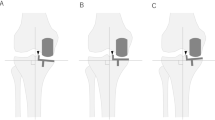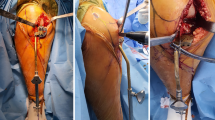Abstract
Purpose
Tibial plateau fractures are serious complications of Oxford mobile-bearing unicompartmental knee arthroplasty (OUKA). This study examined where the fracture lines arises and evaluated the keel–cortex distances (KCDs) using three-dimensional computed tomography (3D-CT) and the effects of technical error (assessed by tibial component positions) and proximal tibial morphology on the KCDs.
Methods
This retrospective study included 217 OUKAs with cementless tibial components. Fifteen patients had tibial fractures after surgery. Anterior and posterior KCDs and fracture line origins were assessed using 3D-CT postoperatively. Proximal tibial morphology was assessed using the medial eminence line (MEL), which runs parallel to the tibial axis and passes through the tip of the medial intercondylar eminence of the tibia on long-leg anteroposterior radiograph. Knees had overhanging medial tibial condyle if the MEL passed medially to the medial tibial cortex. KCDs were compared between patients with/without fractures. Tibial component positions were evaluated, considering effects of tibial morphologies and component positions on fracture prevalence and KCDs.
Results
Fracture lines were found between the keel and posterior cortex in 12/15 patients. Posterior KCDs were significantly shorter in patients with fractures than in patients without (2.7 ± 1.6 mm vs 5.2 ± 1.7 mm, P < 0.001). Patients with medial overhanging condyles were more likely to have fracture (10/51 vs 5/166, P < 0.001) and had significantly shorter posterior KCD than those without (3.6 ± 1.5 mm vs 5.5 ± 1.8 mm, P < 0.001). Patients with tibial component that was set too medial, low, and valgus had higher rates of fracture than those without (7/39 vs 8/178, P = 0.008). Medial (r = 0.30, P < 0.001), low (r = -0.33, P < 0.001), and valgus implantations (r = 0.35, P < 0.001) of tibial components were related to shorter posterior KCDs.
Conclusion
Short posterior KCD after OUKA is a risk factor for postoperative tibial fracture. Patients with either malposition of the tibial component (too medial, low, and valgus) and/or a medial overhanging condyle exhibit a shorter distance of posterior KCD and higher rate of fracture.
Level of evidence: Level III.







Similar content being viewed by others
References
Akagi M, Oh M, Nonaka T, Tsujimoto H, Asano T, Hamanishi C (2004) An anteroposterior axis of the tibia for total knee arthroplasty. Clin Orthop Relat Res 213–219
Akan B, Karaguven D, Guclu B, Yildirim T, Kaya A, Armangil M et al (2013) Cemented versus uncemented oxford unicompartmental knee arthroplasty: is there a difference? Adv Orthop 2013:245915
Asada S, Inoue S, Tsukamoto I, Mori S, Akagi M (2019) Obliquity of tibial component after unicompartmental knee arthroplasty. Knee 26:410–415
Berger RA, Meneghini RM, Jacobs JJ, Sheinkop MB, Della Valle CJ, Rosenberg AG et al (2005) Results of unicompartmental knee arthroplasty at a minimum of ten years of follow-up. J Bone Joint Surg Am 87:999–1006
Boonen B, Kerens B, Schotanus MG, Emans P, Jong B, Kort NP (2016) Inter-observer reliability of measurements performed on digital long-leg standing radiographs and assessment of validity compared to 3D CT-scan. Knee 23:20–24
Clarius M, Haas D, Aldinger PR, Jaeger S, Jakubowitz E, Seeger JB (2010) Periprosthetic tibial fractures in unicompartmental knee arthroplasty as a function of extended sagittal saw cuts: an experimental study. Knee 17:57–60
Dawson J, Fitzpatrick R, Murray D, Carr A (1998) Questionnaire on the perceptions of patients about total knee replacement. J Bone Joint Surg Br 80:63–69
Durlak JA (2009) How to select, calculate, and interpret effect sizes. J Pediatr Psychol 34:917–928
Faul F, Erdfelder E, Buchner A, Lang AG (2009) Statistical power analyses using G*Power 3.1: tests for correlation and regression analyses. Behav Res Methods 41:1149–1160
Giffin JR, Vogrin TM, Zantop T, Woo SL, Harner CD (2004) Effects of increasing tibial slope on the biomechanics of the knee. Am J Sports Med 32:376–382
Hiranaka T, Tanaka T, Fujishiro T, Anjiki K, Nagata N, Kitazawa D et al (2019) A modified under-vastus approach for knee arthroplasty with anatomical repair of soft tissue. Clin Orthop Surg 11:490–494
Hiranaka T, Yoshikawa R, Yoshida K, Michishita K, Nishimura T, Nitta S, et al. (2020) Tibial shape and size predicts the risk of tibial plateau fracture after cementless unicompartmental knee arthroplasty in Japanese patients. Bone Joint J 102-B:861–867
Hurst JM, Berend KR, Adams JB, Lombardi AV Jr (2015) Radiographic comparison of mobile-bearing partial knee single-peg versus twin-peg design. J Arthroplasty 30:475–478
Kamath GV, Murphy T, Creighton RA, Viradia N, Taft TN, Spang JT (2014) Anterior cruciate ligament injury, return to play, and reinjury in the elite collegiate athlete: analysis of an NCAA division I cohort. Am J Sports Med 42:1638–1643
Kamenaga T, Hiranaka T, Hida Y, Fujishiro T, Okamoto K (2018) Effect of tibial component position on short-term clinical outcome in Oxford mobile bearing unicompartmental knee arthroplasty. J Orthop Sci 23:807–810
Kamenaga T, Hiranaka T, Kikuchi K, Hida Y, Fujishiro T, Okamoto K (2018) Influence of tibial component rotation on short-term clinical outcomes in Oxford mobile-bearing unicompartmental knee arthroplasty. Knee 25:1222–1230
Kamenaga T, Hiranaka T, Nakanishi Y, Takayama K, Kuroda R, Matsumoto T (2019) Valgus subsidence of the tibial component caused by tibial component malpositioning in cementless oxford mobile-bearing unicompartmental knee arthroplasty. J Arthroplasty 34:3054–3060
Liddle AD, Judge A, Pandit H, Murray DW (2014) Adverse outcomes after total and unicompartmental knee replacement in 101,330 matched patients: a study of data from the National Joint Registry for England and Wales. Lancet 384:1437–1445
Liddle AD, Pandit H, O'Brien S, Doran E, Penny ID, Hooper GJ, et al. (2013) Cementless fixation in Oxford unicompartmental knee replacement: a multicentre study of 1000 knees. Bone Joint J 95-B:181–187
Matsuda S, Mizu-uchi H, Miura H, Nagamine R, Urabe K, Iwamoto Y (2003) Tibial shaft axis does not always serve as a correct coronal landmark in total knee arthroplasty for varus knees. J Arthroplasty 18:56–62
Mohammad HR, Matharu GS, Judge A, Murray DW (2020) Comparison of the 10-year outcomes of cemented and cementless unicompartmental knee replacements: data from the National Joint Registry for England, Wales, Northern Ireland and the Isle of Man. Acta Orthop 91:76–81
Mori S, Akagi M, Asada S, Matsushita T, Hashimoto K (2013) Tibia vara affects the aspect ratio of tibial resected surface in female Japanese patients undergoing TKA. Clin Orthop Relat Res 471:1465–1471
Nagamine R, Kondo K, Ikemura S, Shiranita A, Nakashima S, Hara T et al (2004) Distal femoral cut perpendicular to the mechanical axis may induce varus instability in flexion in medial osteoarthritic knees with varus deformity in total knee arthroplasty: a pitfall of the navigation system. J Orthop Sci 9:555–559
Nagamine R, Miyanishi K, Miura H, Urabe K, Matsuda S, Iwamoto Y (2003) Medial torsion of the tibia in Japanese patients with osteoarthritis of the knee. Clin Orthop Relat Res;https://doi.org/10.1097/00003086-200303000-00028218-224
Pandit H, Jenkins C, Barker K, Dodd CA, Murray DW (2006) The Oxford medial unicompartmental knee replacement using a minimally-invasive approach. J Bone Joint Surg Br 88:54–60
Pandit H, Liddle AD, Kendrick BJ, Jenkins C, Price AJ, Gill HS et al (2013) Improved fixation in cementless unicompartmental knee replacement: five-year results of a randomized controlled trial. J Bone Joint Surg Am 95:1365–1372
Pandit H, Murray DW, Dodd CA, Deo S, Waite J, Goodfellow J et al (2007) Medial tibial plateau fracture and the Oxford unicompartmental knee. Orthopedics 30:28–31
Price AJ, Svard U (2011) A second decade lifetable survival analysis of the Oxford unicompartmental knee arthroplasty. Clin Orthop Relat Res 469:174–179
Rudol G, Jackson MP, James SE (2007) Medial tibial plateau fracture complicating unicompartmental knee arthroplasty. J Arthroplasty 22:148–150
Sekiguchi K, Nakamura S, Kuriyama S, Nishitani K, Ito H, Tanaka Y et al (2019) Effect of tibial component alignment on knee kinematics and ligament tension in medial unicompartmental knee arthroplasty. Bone Joint Res 8:126–135
Sloper PJ, Hing CB, Donell ST, Glasgow MM (2003) Intra-operative tibial plateau fracture during unicompartmental knee replacement: a case report. Knee 10:367–369
Song MH, Kim BH, Ahn SJ, Yoo SH, Lee MS (2009) Early complications after minimally invasive mobile-bearing medial unicompartmental knee arthroplasty. J Arthroplasty 24:1281–1284
White SH, Ludkowski PF, Goodfellow JW (1991) Anteromedial osteoarthritis of the knee. J Bone Joint Surg Br 73:582–586
Yokoyama M, Nakamura Y, Egusa M, Doi H, Onishi T, Hirano K, et al. (2019) Factors related to stress fracture after unicompartmental knee arthroplasty. Asia Pac J Sports Med Arthrosc Rehabil Technol 15:1–5
Yoshikawa R, Hiranaka T, Okamoto K, Fujishiro T, Hida Y, Kamenaga T et al (2020) The medial eminence line for predicting tibial fracture risk after unicompartmental knee arthroplasty. Clin Orthop Surg 12:166–170
Acknowledgements
The authors would like to thank Mr. Benjamin Phillis at the Clinical Study Support Center, Wakayama Medical University for proofreading and editing.
Funding
The authors received no specific funding for this work.
Author information
Authors and Affiliations
Contributions
TK performed data analysis, and wrote the original draft. TF ank KO performed data curation. TH and TM revised the manuscript. NN performed validation analysis, SH and RK reviewed and edited the manuscript.
Corresponding author
Ethics declarations
Conflict of interest
The authors declare no conflicts of interest associated with this manuscript.
Ethical approval
This work was approved by the Institutional Review Board in Takatsuki General Hospital.
Informed consent
A written informed consent was obtained from each patient.
Additional information
Publisher's Note
Springer Nature remains neutral with regard to jurisdictional claims in published maps and institutional affiliations.
Rights and permissions
About this article
Cite this article
Kamenaga, T., Hiranaka, T., Nakano, N. et al. Short distance from the keel to the posterior tibial cortex is associated with fracture after cementless Oxford UKA in Asian patients. Knee Surg Sports Traumatol Arthrosc 30, 1220–1230 (2022). https://doi.org/10.1007/s00167-021-06553-4
Received:
Accepted:
Published:
Issue Date:
DOI: https://doi.org/10.1007/s00167-021-06553-4




